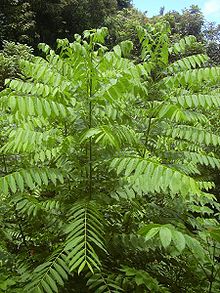
Mahogany is a straight-grained, reddish-brown timber of three tropical hardwood species of the genus Swietenia, indigenous to the Americas and part of the pantropical chinaberry family, Meliaceae. Mahogany is used commercially for a wide variety of goods, due to its coloring and durable nature. It is naturally found within the Americas, but has also been imported to plantations across Asia and Oceania. The mahogany trade may have begun as early as the 16th century and flourished in the 17th and 18th centuries. In certain countries, mahogany is considered an invasive species.

Meliaceae, the mahogany family, is a flowering plant family of mostly trees and shrubs in the order Sapindales.
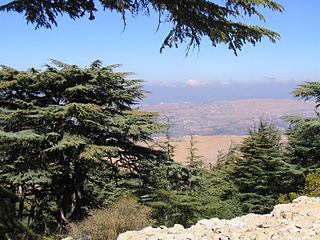
Cedrus, with the common English name cedar, is a genus of coniferous trees in the plant family Pinaceae. They are native to the mountains of the western Himalayas and the Mediterranean region, occurring at altitudes of 1,500–3,200 m in the Himalayas and 1,000–2,200 m in the Mediterranean.
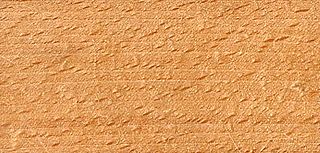
Hardwood is wood from dicot trees. These are usually found in broad-leaved temperate and tropical forests. In temperate and boreal latitudes they are mostly deciduous, but in tropics and subtropics mostly evergreen. Hardwood contrasts with softwood.
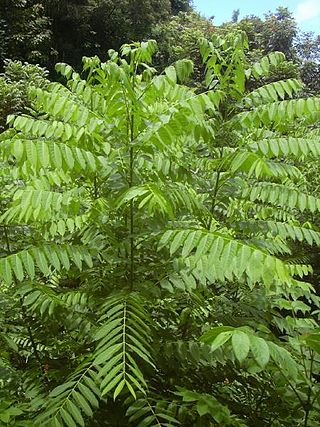
Cedrela is a genus of several species in the mahogany family, Meliaceae. They are evergreen or dry-season deciduous trees with pinnate leaves, native to the tropical and subtropical New World, from southern Mexico south to northern Argentina.

Entandrophragma cylindricum is a tree of the genus Entandrophragma of the family Meliaceae. It is commonly known as sapele or sapelli or sapele mahogany, as well as aboudikro, assi, and muyovu.
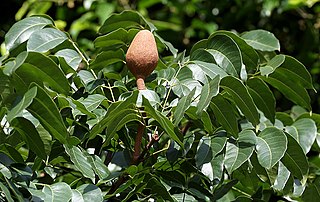
Swietenia is a genus of trees in the chinaberry family, Meliaceae. It occurs natively in the Neotropics, from southern Florida, the Caribbean, Mexico and Central America south to Bolivia. The genus is named for Dutch-Austrian physician Gerard van Swieten (1700–1772). The wood of Swietenia trees is known as mahogany.
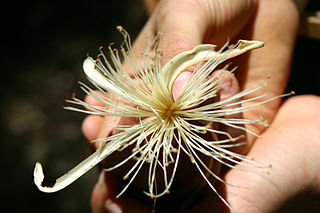
Pachira quinata, commonly known as pochote, is a species of flowering tree in the mallow family, Malvaceae. It inhabits dry forests in Costa Rica, Nicaragua, Honduras Panama, Venezuela, and Colombia. Pochotes bear large, stubby thorns on their trunk and branches and are often planted as living fenceposts with barbed wire strung between them. These thorns are also often used to make small house-like sculptures that are believed to bring protection to someone's house since the pochote is believed to be sacred.

Calophyllum brasiliense (guanandi) is a species of plant in the family Calophyllaceae. It is native to subtropical and tropical regions of Mexico, Central America, South America and the Caribbean.

Toona ciliata is a forest tree in the mahogany family which grows throughout South Asia from Afghanistan to Papua New Guinea and Australia.
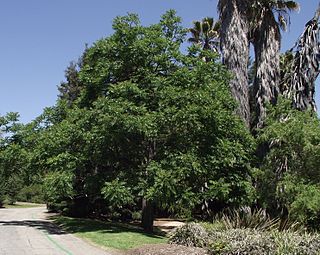
Cedrela fissilis is a species of tree in the family Meliaceae. It is native to Central and South America, where it is distributed from Costa Rica to Argentina. Its common names include Argentine cedar, cedro batata, cedro blanco, "Acaju-catinga" and cedro colorado.

Cedrela angustifolia is a species of tree in the mahogany family, Meliaceae. Local common names include cedro de Tucumán, cedro bayo, cedro coya, and cedro del cerro. It is native to South America, where it occurs in Argentina, Bolivia and Peru.

Swietenia mahagoni, commonly known as American mahogany, Cuban mahogany, small-leaved mahogany, and West Indian mahogany, is a species of Swietenia native to the broader Caribbean bioregion. It is the species from which the original mahogany wood was produced. Mahogany is grown as a plantation tree and sold in timber markets in Kerala, India. Swietenia mahagoni is listed as "Threatened" in the Preservation of Native Flora of Florida Act. It is the national tree of the Dominican Republic.
The Bahamian dry forests are a tropical and subtropical dry broadleaf forest ecoregion in the Bahamas and the Turks and Caicos Islands, covering an area of 4,900 km2 (1,900 sq mi). They are found on much of the northern Bahamas, including Andros, Abaco, and Grand Bahama, where they are known as coppices. Dry forests are distributed evenly throughout the Turks and Caicos.
Odoratus is a Latin adjective meaning "fragrant, perfumed", and may refer to:

The Cuban dry forests are a tropical dry forest ecoregion that occupies 65,800 km2 (25,400 sq mi) on Cuba and Isla de la Juventud. The ecoregion receives 1,000–2,000 mm (39–79 in) of rainfall annually. Cuban dry forests can be differentiated into evergreen forests, semi-deciduous forests, mogotes, and sclerophyllous low forests.

Scalesia pedunculata is a flowering plant species in the family Asteraceae, growing to a slender tree, and found in dense stands on the humid windward coasts of the islands of Santa Cruz, San Cristobal, Santiago and Floreana in the Galapagos Islands. The Galapagos archipelago lies in the southeast trade wind zone, so that climate and weather are dominated by the moisture-bearing trade winds and the topography of the islands. In general, the windward sides of the islands have a much higher precipitation than the leeward sides. Scalesia pedunculata is regarded as vulnerable because of human encroachment, invasive introduced plant species such as Cedrela odorata and Psidium guajava, and grazing by introduced goats. Fires and cutting for fuel are also contributory problems, though the tree's wood is soft, with a large, pithy centre.

Toona sureni is a species of tree in the mahogany family. It is native to South Asia, Indochina, Malesia, China, and Papua New Guinea. It is commonly known as the suren toon, surian, limpaga, iron redwood or the red cedar. It is also known as the Indonesian mahogany or the Vietnamese mahogany. The species is a valuable timber tree.
